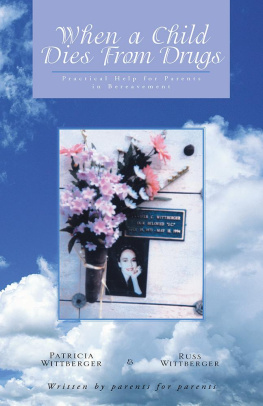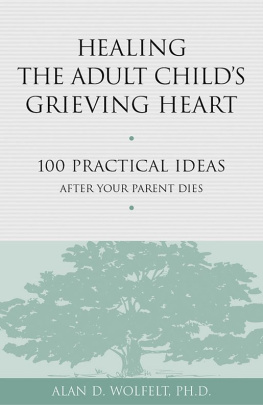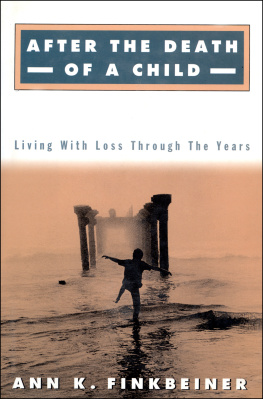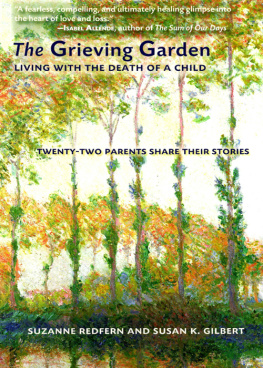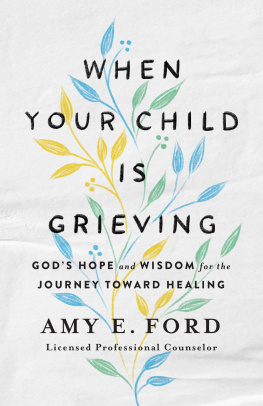When Your Child Dies
When Your
Child Dies
Tools for Mending
Parents Broken Hearts
Avril Nagel and
Randie Clark, MA, CCC
New Horizon Press
Far Hills, NJ
Copyright 2012 by Avril Nagel and Randie Clark
All rights reserved. No portion of this book may be reproduced or transmitted in any form whatsoever, including electronic, mechanical or any information storage or retrieval system, except as may be expressly permitted in the 1976 Copyright Act or in writing from the publisher.
Requests for permission should be addressed to:
New Horizon Press
P.O. Box 669
Far Hills, NJ 07931
Description of intuitive and instrumental grievers from Men Dont Cry... Women Do: Transcending Gender Stereotypes of Grief by Terry L. Martin and Kenneth J. Doka, Copyright 2011. Reproduced with permission of Taylor & Francis Group LLC and Brunner/Mazel.
Avril Nagel and Randie Clark
When Your Child Dies: Tools for Mending Parents Broken Hearts
Cover design: Wendy Bass
Interior design: Scribe Inc.
Library of Congress Control Number: 2012932039
ISBN-13 (eBook): 978-0-88282-411-6
New Horizon Press
Manufactured in the U.S.A.
161514131212345
For Bereaved Parents
and for our sons, David and Alden
When we hold back our feelings and ignore our pain
we are committing violence against ourselves.
THICH NHAT HAHN,
CREATING TRUE PEACE
AUTHORS NOTE
T his book is based on the authors research, personal experiences and bereaved parents real life experiences. In order to protect privacy, names have been changed and identifying characteristics have been altered except for contributing experts.
For purposes of simplifying usage, the pronouns s/he and his/her are sometimes used interchangeably. The information contained herein is not meant to be a substitute for professional evaluation and therapy with mental health professionals.
CONTENTS
N o parents imagine that their children will die before them. When the unthinkable happens, there is no preparation for the new, consuming reality that overtakes them on lifes journey.
When our sons died, our life paths were profoundly changed. The unbearable grief stunned us into immobilitythen, as the pain softened, we both tried to find our way back to ourselves. Our search for guiding information was overwhelming, lonely and disjointed at times; sometimes we found a piece here, a bit there. It was hard to find comprehensive information that was specific to the different circumstances in which each of our children died. Our experiences taught us that there is no roadmap for navigating the death of a child. Slowly we began to recognize that grieving parents need a resource that can help them understand the tragedy that has happened to them, recover from the trauma and begin to move forward.
This book is a work of love that we offer with honor in our hearts for those you have lost. We hope the information and tools you find in this book will guide you on your journey toward healing. We encourage you to remember that although nothing can fill the absence of your child or erase your terrible loss, you will get better, little by little. You will discover new ways of being in the world and once again feel engaged in your life.
The main sources of this book are personal experience, research and interviews. We interviewed more than thirty parents whose children died in a variety of circumstances. Randie has worked with bereaved parents for over ten years through her counseling practice and bereavement support groups. The silent backbone of the book is drawn from what we each learned following the traumatic and sudden loss of our sons.
This book is written for parents, but it also offers valuable insight for professionals and others who are helping bereaved parents. If you are a professional, educator or concerned friend, we welcome and support your interest in learning how to better serve and assist bereaved parents.
Since losing a child involves so many different kinds of experiences, we address the psychological, emotional and spiritual experiences related to grieving that loss. Chapters in the book are devoted to the interplay between trauma and grief and how it influences your bereavement. With this information we hope to empower you to be active and healthy in your journey of grieving, mourning and rebuilding your life.
A BOOK JUST FOR PARENTS
The relationship between parent and child is like no other. Parents feel a deep sense of responsibility to protect and nurture their children. Their roles are to love and guide their children to maturity and beyond. But when a child dies, a parents heart is shattered. The shock can flood a parents body and mind with a complex combination of overwhelming trauma responses, which mix with searing grief emotions, complicating the parents reactions and influencing his or her recovery. The sharp loss touches and challenges every aspect of a parents life and identity, including his or her understanding of the world. The complexities of the loss of a child cause a bereaved parents healing journey to be multi-layered.
Although our cultural and social responses to grief and loss have many valuable supports to offer, after experiencing our own losses and realizing the conflicts of heart and mind of many to whom we spoke, we felt the need to go beyond the general and delve into the specific heartaches and deeper issues with which grieving parents struggle. This book speaks directly to parents whose children have died.
If you are a bereaved parent, our hearts reach out to you. Though there are no two losses alike, what bereaved parents share is a common knowing. In this book we try to illuminate the issues specific to child loss as well as provide information, support, strategies and tools to guide you on your journey. Within the text we use the terms parent(s) and you to mean anyone in a parental role, such as a mother, father, stepparent or caretaker.
TASKS OF MOURNING
Grief and mourning do not progress in direct, predictable lines and the experience of loss is different for each person. All parents must do their own work to grieve in healthy ways and to incorporate the death into their ongoing lives. The Tasks of Mourning are guidelines that help to contextualize the journey of grief. These steps do not occur in any special order. Our four Tasks of Mourning are based on those outlined by J. W. Worden in his book Grief Counseling and Grief Therapy: A Handbook for the Mental Health Practitioner. We have adapted the wording of the tasks to reflect the unique nature of each parents bereavement.
Coming to terms with the reality of your loss
When the shock and numbness of the immediate death of your child begins to diminish, you may feel the sharp pain of grief. This is a time when the reality of the death and loss begins to penetrate your awareness and comprehension. Though you may have moments of absolute disbelief, there will be daily reminders of your childs absence. Acknowledging the reality of the death will help define your next steps along the path.
Experiencing the pain of your loss
The emotions of grieving a loss are natural, human responses. If grieving is to be healthy, you must allow yourself to express and release your feelings. Attempting to suppress, avoid, numb or deny your feelings can hinder, complicate and prolong grief. Some mourners believe that holding onto the pain will defer a childs absence or sustain their love for their deceased children, but the pain neednt be held onto. Pain will dissipate as you release it. Youll learn in the process that you are capable of deep emotions and strong enough to give voice to them.
Next page

